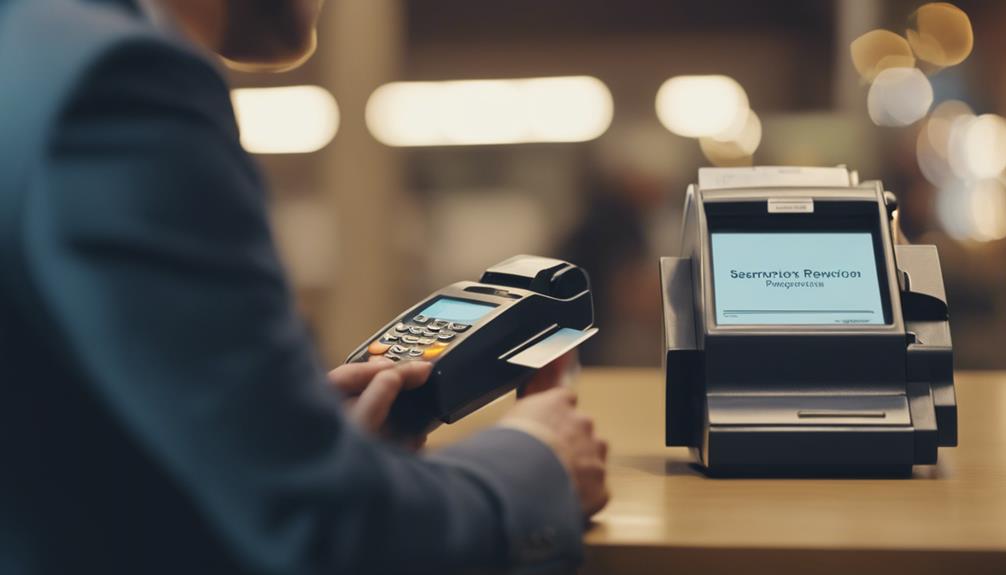To minimize chargebacks in your credit card processing, verify customer information to prevent fraud. Enhance expectations management by providing detailed product descriptions. Deliver exceptional customer service for prompt issue resolution. Use secure payment gateways to protect data. Offer hassle-free return and refund policies. Ensure transparent transactions to build customer trust. Decrease chargeback likelihood through strategic measures like AVS, 3D Secure, and CVV verification. By implementing these strategies, you can safeguard your business and enhance customer satisfaction while reducing financial risks. Learn more about effective chargeback prevention methods by exploring thorough fraud prevention tactics and customer service excellence.
Key Takeaways
- Implement Address Verification Service (AVS) for accurate billing details.
- Utilize 3D Secure for secure online transactions.
- Monitor transactions for suspicious activities to prevent fraud.
- Educate customers on recognizing legitimate transactions to reduce disputes.
- Require CVV/CVC for Card-Not-Present transactions for added security.
Verify Customer Information for Fraud Prevention

To enhance fraud prevention measures in credit card processing, verifying customer information through services like Address Verification Service (AVS) is vital. By confirming the accuracy of customer-provided billing details against the issuing bank's records, AVS plays a pivotal role in thwarting fraudulent activities.
This verification process acts as an important shield against unauthorized transactions, greatly reducing the occurrence of chargebacks that can lead to financial losses for your business. AVS helps flag suspicious transactions, prompting further scrutiny and potentially preventing fraudulent charges before they occur.
Ensuring that customer information is accurately verified not only protects your business but also enhances customer trust and satisfaction. By incorporating robust address verification practices into your transaction processing, you can fortify your defenses against fraud, minimize chargeback disputes, and safeguard your financial well-being.
Ensure Clear Product Descriptions for Expectations Management

By ensuring your product descriptions are clear and detailed, you can effectively manage customer expectations and reduce the risk of dissatisfaction chargebacks. Clear product information is key to preventing misunderstandings and disputes. Here are three ways clear product descriptions can benefit your business:
- Set Accurate Expectations: Detailed descriptions help customers know exactly what they're purchasing, reducing the chances of receiving a product different from what they expected.
- Informed Purchasing Decisions: Providing realistic visuals and accurate specifications enables customers to make informed choices, leading to higher satisfaction and fewer chargebacks.
- Minimize Disputes: Clear shipping details and concise product information can lower the likelihood of customers disputing charges due to confusion or unmet expectations.
Provide Excellent Customer Service for Prompt Issue Resolution

To guarantee minimal chargebacks, it's important to provide swift resolution to customer issues. Quality customer support plays a key role in enhancing satisfaction and reducing disputes.
Swift Issue Resolution
Quickly resolving customer issues is crucial in minimizing chargebacks in credit card processing. To guarantee prompt issue resolution and excellent customer service, follow these strategies:
- Respond promptly: Acknowledge customer concerns swiftly to show you value their feedback.
- Communicate effectively: Keep customers informed about the progress of issue resolution to build trust.
- Offer solutions: Provide practical solutions to address customer issues effectively and prevent escalations.
Quality Customer Support
Ensuring exceptional customer support is essential for promptly resolving issues and reducing the risk of chargebacks in credit card processing. Quality customer support plays a vital role in addressing disputes and communicating effectively with customers to resolve issues swiftly.
Timely responses to inquiries and concerns not only improve satisfaction but also help minimize disputes that could lead to chargebacks. By providing clear communication channels and support options, businesses can enhance the overall customer experience and mitigate the likelihood of chargebacks.
Efficiently handling customer complaints and issues can result in fewer disputes, ultimately safeguarding against potential chargebacks. Offering round-the-clock customer support further builds trust and loyalty, contributing to a decreased risk of disputes and chargebacks.
Use Secure Payment Gateways for Data Protection

Secure payment gateways play an essential role in safeguarding sensitive customer data during credit card transactions. When you utilize a secure payment gateway, you protect yourself and your customers from potential risks such as credit card fraud and data breaches. Here's how secure payment gateways benefit you:
- Data Encryption: Secure payment gateways encrypt all sensitive information, ensuring that it's transmitted securely and can't be intercepted by malicious actors.
- Fraud Prevention: By tokenizing card details, secure payment gateways reduce the likelihood of fraud, giving you and your customers peace of mind.
- Compliance with Standards: These gateways adhere to industry regulations like PCI DSS, guaranteeing that your payment information is handled according to strict security protocols.
Offer Hassle-Free Returns and Refunds Policies

To enhance customer satisfaction and minimize chargeback disputes, it's vital to establish clear and efficient return and refund policies. By clearly outlining your return and refund policies, you can reduce customer confusion and prevent misunderstandings that may lead to chargebacks.
Providing hassle-free return processes with easy steps and clear instructions encourages customers to return items directly to you, reducing the risk of return fraud and chargeback disputes. It's important to offer refunds promptly and efficiently to prevent dissatisfied customers from resorting to chargebacks.
Implementing a user-friendly online return portal or system can streamline the return process, making it easier for customers to navigate and decreasing the chances of frustration. Communicate your return policy details prominently on your website and in confirmation emails to set clear expectations and minimize misunderstandings, ultimately fostering trust and loyalty with your customers while reducing the likelihood of chargeback disputes.
Enhance Transaction Transparency for Trust-Building

Improving transaction transparency is essential for building trust with your customers. By offering clear and detailed transaction descriptions, you can boost customer confidence in their purchases.
Additionally, transparent billing descriptors and easily recognizable merchant names help decrease disputes and enhance payment security.
Clear Transaction Details
Improving transaction clarity through detailed descriptors and purchase information is essential for minimizing chargebacks in credit card processing. To enhance transparency and trust, follow these guidelines:
- Include specific purchase details on the credit card statement to help customers easily recognize transactions.
- Use clear billing descriptors that accurately reflect the purpose of the transaction for better understanding.
- Provide compelling evidence, such as proof of delivery or service, to support transactions and prevent disputes.
Build Customer Confidence
Building customer confidence in credit card transactions involves ensuring transparency and trust through clear communication and secure processes. Display detailed transaction descriptions so customers can easily recognize purchases. Provide order confirmations with itemized breakdowns for transaction transparency.
Utilize secure payment gateways and encryption to protect sensitive data during transactions. Implement two-factor authentication to enhance security and build trust in online purchases. Use recognizable billing descriptors on credit card statements to reduce confusion and potential chargeback triggers.
Increase Payment Security
Increase payment security by implementing 3D Secure protocols to authenticate online transactions and reduce fraud risk.
Utilize Address Verification Service (AVS) to match cardholder information for added security.
Offer secure payment gateways and SSL encryption to protect customer data during transactions.
Display clear transaction details on statements to help customers easily recognize and verify purchases.
Use tokenization technology to replace sensitive card data with unique tokens, enhancing transaction security.
By incorporating these strategies, you can prevent fraudulent transactions, reduce payment disputes, and build trust with your customers.
Ensuring the security of their transactions not only safeguards your business but also fosters a sense of reliability and confidence among consumers.
Build Customer Trust With Transparent Transactions

To establish trust with customers, guarantee that all transaction details are clearly stated, including pricing, terms, and conditions. By providing transparent transactions, you demonstrate a commitment to honesty and reliability.
Offering secure payment options and encryption safeguards sensitive customer information, enhancing their confidence in the process. Implementing fraud prevention measures like address verification systems (AVS) and CVV verification further solidifies the security of transactions.
Additionally, having clear and accessible customer support channels in place ensures that any concerns or issues can be addressed promptly, reinforcing trust with your customers.
Keeping customers informed about the status of their transactions and providing tracking information for shipped items adds transparency to the process, leading to increased customer satisfaction. Transparent transactions not only build customer trust but also contribute to a positive overall experience, reducing the likelihood of chargebacks in your credit card processing.
Decrease Chargeback Likelihood Through Strategic Measures

By implementing strategic measures, you can effectively reduce the likelihood of chargebacks in credit card processing. To safeguard your business against fraud and friendly fraud chargebacks, consider the following steps:
Implement a robust fraud detection system that can flag potentially suspicious transactions. This can help prevent chargebacks related to unauthorized transactions. Additionally, consider utilizing fee reduction strategies offered by your credit card processor, such as address verification services and chargeback prevention tools. These measures can help minimize chargeback costs and protect your business from financial losses.
- Implement Address Verification Service (AVS): Verifying cardholder addresses can greatly decrease the chances of disputes arising from unrecognized transactions.
- Utilize 3D Secure for Online Retailers: Enhance security for online transactions by incorporating 3D Secure protocols, reducing the risk of fraudulent chargebacks.
- Require CVV/CVC for Card-Not-Present Transactions: Adding an extra layer of security by requesting the card verification code for online purchases can help prevent unauthorized transactions and minimize chargeback occurrences.
Frequently Asked Questions
How to Reduce Credit Card Chargebacks?
To reduce credit card chargebacks, there are several key strategies that can be implemented:
- Verify cardholder information with Address Verification Service (AVS) and require CVV/CVC for card-not-present transactions. This helps to authenticate cardholders and add an extra layer of security to transactions.
- Use 3D Secure for online purchases. This protocol adds an additional layer of authentication for online transactions, reducing the risk of fraudulent activities.
- Employ fraud detection services to prevent fraudulent transactions. Utilizing advanced technology and monitoring tools can help identify and stop potentially fraudulent transactions before they occur.
- Stay informed with chargeback alerts and notifications. Being aware of chargeback requests in real-time allows businesses to respond promptly and address any issues, potentially resolving disputes before they escalate.
How Do You Protect Yourself From Chargebacks?
To protect yourself from chargebacks, you should prioritize fraud prevention measures like AVS, 3D Secure, and CVV verification.
Stay vigilant with chargeback alerts and maintain thorough documentation.
By implementing these strategies, you can reduce the risk of disputes and safeguard your business from financial losses.
How Do Companies Prevent Chargebacks?
To prevent chargebacks, companies should implement Address Verification Service (AVS) and require CVV/CVC for card-not-present transactions. Utilizing 3D Secure for online transactions and employing fraud detection services can add extra layers of security. Additionally, staying informed through chargeback alerts and notifications allows proactive measures to be taken.
How to Manage Chargebacks?
To manage chargebacks effectively, you must track and analyze trends in your business's chargeback data.
Implement prevention strategies like maintaining detailed transaction documentation and using tools such as Address Verification Service (AVS) and 3D Secure for online transactions.
Regularly review chargeback reports to detect potential issues early on.
Conclusion
To wrap up, implementing strategies to minimize chargebacks in your credit card processing can greatly benefit your business. Did you know that chargebacks cost merchants an estimated $31 billion annually?
By verifying customer information, providing clear product descriptions, offering excellent customer service, and using secure payment gateways, you can reduce the likelihood of chargebacks and protect your bottom line.
Stay proactive and vigilant in managing your transactions to guarantee a smooth and secure payment process.











